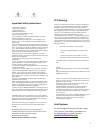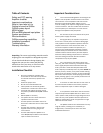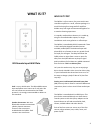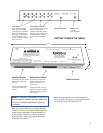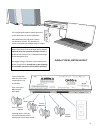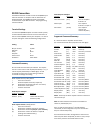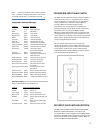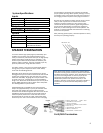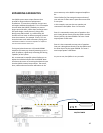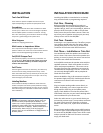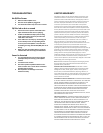
7
RS232 Connection
The RS232 connection is used to control the Q450RS by an
external controller or computer and can work with our
without keypads. The Q450RS connects to the RS232
controller with a 9-pin db9 connector. The programming
reference follows.
Terminal Settings
To control the Q450RS amplifier via other control systems,
connect a RS-232 cable to the serial control connector on
the rear of the Q450RS and set your computer’s or control
unit port settings to match the following configuration:
Setting Value
Bits per second 19,200
Data bits 8
Parity None
Stop bits 1
Flow control None
Emulation Auto detect
Command Summary
All commands are enclosed in parentheses. The request
can be in some cases a read request (followed by a “?”), or
a write request (followed by 0-2 ASCII digits). A read
command will return the current setting, and write
command will change the setting.
Read request format: (nAA?) where:
( starts the command
n denotes amplifier channel (if required)
AA denotes the command (may be 1 or 2 letters)
? denotes the read request
) ends the command
Read Request Example:
Function Command Response
Volume (1vl?) returns the volume on
channel 1 (0-87)
Write request format (nAA$$) where:
( starts the command
n denotes the amplifier channel (if required)
AA denotes the command (may be 1, 2 or 3 letters )
$$ denotes the value to be written if required
(leading zero’s ARE necessary)
) ends the command
Write Request Examples:
Function Command Response
Turn Channel On (1on) turns on amplifier
channel 1 on
Select Input (1sl4) turn amplifier
channel 1 to input 4
Set Volume (1vl50) turn amplifier
channel 1 to
volume 50 (of 87)
Supported Command Summary
# = numerical zone or amplifier channel value
$$ = second numerical value (may be one or two digits)
Function Command Range Read/Write Remarks
Version (vr?) none read only
Reset (rx) none write only 1 second
Channel On (#on) 1-4 write only
Channel Off (#of) 1-4 write only
Mute (#mu) 1-4 write only
Un-mute (#um) 1-4 write only
Mute All (amu) none write only
Un-mute All (aum) none write only
Volume Request (#vl?) 1-4 read only
Volume Set (#vl$$) 1-4 / 0-87 write only
Volume All (avl$$) 0-87 write only
Input Request (#sl?) 1-4 read only
Input Set (#sl$) 1-4 / 1-4 write only
Input Select All (asl$) 1-4 write only
All Channels On (aon) none write only
All Channels Off (aof) none write only
All Channels Vol up (avlu) none write only Note 1
All Channels Vol dn (avld) none write only Note 1
Channel Vol up (#vlu) 1-4 write only Note 1
Channel Vol down (#vld) 1-4 write only Note 1
Bass adjustment (#b$) 1-4 / 0-F write only Note 2
Treble adjustment (#t$) 1-4 / 0-F write only Note 2
Display treble (#b?) 1-4 read only
Display bass (#t?) 1-4 read only
Note1: Volume up or down requests increase or decrease
volume level by 5
Note 2: Treble and bass commands use hexadecimal
values 0-F, default (flat) is 8.
Also, it is best to leave about a ½ second between
commands, as some integrators may miss commands if
they are entered too quickly.
All commands also send a message back to the terminal
after they have been completed, so that it is easy to keep
track of the previous commands that were sent.




